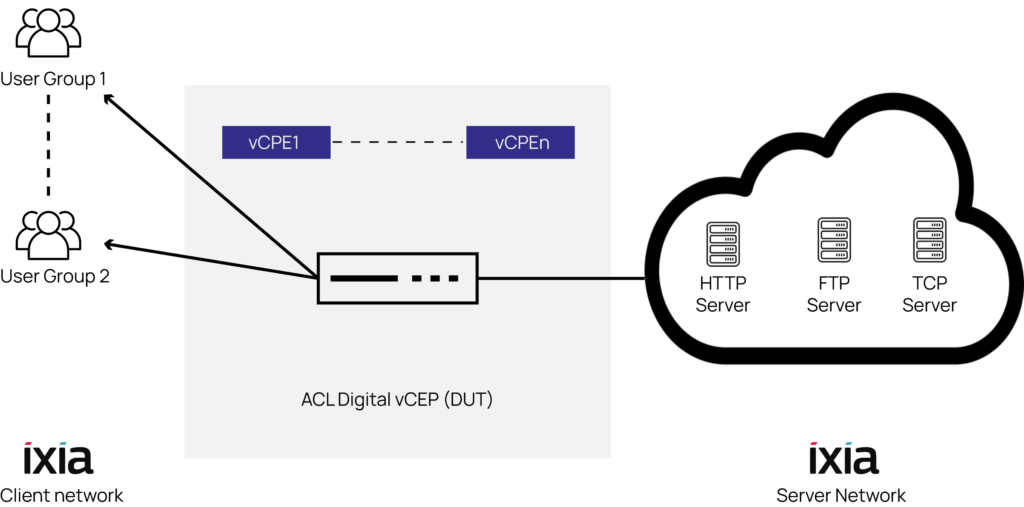


Sagar Nangare
5 Minutes read
Transforming Telecommunications: ACL Digital’s Blueprint for High-Performance NFV
The telecommunications industry has undergone a seismic shift. For decades, network services like routing and firewalls were tied to dedicated, often expensive, hardware appliances. The arrival of Network Functions Virtualization (NFV) revolutionized the industry, transforming these hardware-bound functions into agile, efficient software that runs on standard, off-the-shelf servers. This evolution wasn’t just a trend; it was the foundational shift that enabled modern marvels like 5G and cloud-native networks, bringing unprecedented agility and cost-efficiency to the industry. NFV has significantly reduced the cost of network operations, accelerated service deployment, and improved network scalability and flexibility.
As a pioneer in this space, ACL Digital embraced this transformation early on. Our engineering teams developed a powerful, in-house Virtual Customer Premises Equipment (vCPE) framework—a robust platform designed to empower Network Equipment Manufacturers (NEMs) to build and deploy scalable Virtual Network Functions (VNFs) for both enterprise and broadband networks. This framework is a versatile solution capable of running on various hypervisors and operating systems. This framework, known for its versatility and scalability, can run on various hypervisors and operating systems, ensuring adaptability and future proofing for our clients.
But building an innovative framework is only half the battle. At ACL Digital, we recognize that demonstrating the stability and performance of our solutions under real-world conditions is essential. It’s not just about innovation; it’s about the reliability and robustness of our solutions, which we are committed to demonstrating.
The Challenge: Pushing Virtual Environments to Their Limits
We set a clear goal: to rigorously test and verify the stability of our vCPE framework in two distinct, critical environments:
- A fully virtualized KVM (Kernel-based Virtual Machine) environment1. Here, each virtual function runs in an isolated VM, a standard deployment model for many service providers.
- A Linux Container (LXC)-based environment2. This lightweight, OS-level virtualization promises higher efficiency and density, but we needed to validate its performance for demanding network traffic.

Our testing had to be comprehensive. We needed to confirm session establishment rates and line-rate throughput over long-duration tests3. Stability is paramount because actions like creating or deleting VMs can directly impact on the performance of other services running on the same server. We also needed to test a wide range of traffic, from different packet sizes (64 bytes to 1420 bytes) to a mix of protocols including IP, TCP, UDP, OSPFv2, HTTP, and FTP5.
The Solution: A Strategic Collaboration for Rigorous Testing
To meet these demanding test requirements, we collaborated with Ixia, leveraging their industry-leading test solutions. The Ixia equipment allowed us to simulate real-world scenarios at an immense scale and analyze the results with precision.
Our testbed featured:
- Ixia Xcellon-Ultra XTS40 with IxLoad: This was instrumental in generating high-scale, stateful TCP and UDP traffic, pushing our framework to its 10Gbps full-duplex limit per port6666.
- Ixia XM2/NGY-NP8-01 with IxNetwork: This powerful module emulated a complete real-time user environment, allowing us to test L2-L3 features and verify the statefulness of critical functions like firewalls.
This combination enabled us to emulate over a million L4 sessions, generate multi-protocol traffic, and obtain rich, graphical visualizations of network statistics to pinpoint any bottlenecks.
The Results: Setting New Benchmarks for Performance
After extensive testing, the results validated the exceptional performance and stability of ACL Digital’s vCPE framework on a COTS server equipped with Intel Xeon E5-2680 v2 processors9.
In the KVM Virtual Machine Environment:
- L2-L3 Throughput: The framework delivered an impressive >40 Gbps Full Duplex10.
- Subscriber Capacity: It consistently supported over 500,000 subscriber sessions per CPU core.
In the LXC Container Environment:
- L2-L3 Throughput: Performance soared to over 72 Gbps Full Duplex—a substantial increase on the same hardware12.
- Subscriber Capacity: The framework also maintained support for over 500,000 subscriber sessions per CPU core13131313.
Density and Efficiency: The lightweight nature of LXC containers proved to be a game-changer. We achieved 40 to 50 times higher vCPE densities compared to the VM deployment, with much faster creation and shutdown times1414.
What This Means for the Future of Networking
These test results offer definitive proof that high-performance networking is no longer the exclusive domain of specialized hardware. Our vCPE framework demonstrated that residential and SMB customers can gain immense agility and significant cost savings by deploying virtualized solutions on standard server hardware.
The performance leap seen with LXC containers highlights a path toward even greater efficiency and density in network deployments, allowing providers to run significantly more vCPE instances on the same physical server. This testing unequivocally confirms that our framework is ready to deliver the consistent, high-speed performance required for next-generation network services, be it in a traditional VM or a modern container environment.
Why ACL Digital is the Ideal NFV Transformation Partner
Transforming a network from hardware-bound appliances to virtualized, cloud-ready functions is more than a technical shift—it’s a strategic leap. ACL Digital stands out as a partner who makes this transformation seamless and future-proof.
Strategic Guidance: We provide comprehensive support to organizations, helping them define a clear NFV roadmap that aligns technology adoption with their unique business objectives.
Customized Virtualization Solutions: Our frameworks and expertise are tailored to fit diverse network environments, ensuring maximum performance without compromising flexibility.
Operational Readiness: Beyond development, we ensure solutions are production-ready, with proven reliability, scalability, and resilience, giving you the confidence to move forward.
Accelerated Innovation: By leveraging ACL Digital’s expertise, companies can deploy NFV solutions more quickly, optimize their infrastructure, and unlock new revenue streams.
With ACL Digital as a partner, NFV is not just a technology upgrade—it’s a transformation that redefines network efficiency, agility, and customer experience.
Conclusion
With ACL Digital, you’re not just enabling next-generation networks but ensuring their success.
The future of networking belongs to solutions that are agile, scalable, and efficient. ACL Digital’s vCPE framework demonstrates that high-performance virtualized networks are not only feasible but can also outperform traditional hardware in terms of density and speed.
Partnering with ACL Digital ensures that this transformation is smooth, reliable, and aligned with strategic goals. Together, we help service providers and network equipment manufacturers confidently adopt NFV, transforming technological potential into tangible business outcomes.
Related Insights



How AI-Based Switches Are Redefining Connectivity?

Prompting techniques for QA Engineers


